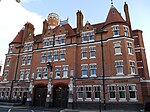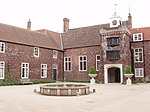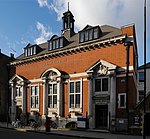The Cock, Fulham
FulhamGrade II listed buildings in the London Borough of Hammersmith and FulhamGrade II listed pubs in LondonPub stubsPubs in the London Borough of Hammersmith and Fulham

The Cock is a Grade II listed public house at 360 North End Road, Fulham, London.It was built in the mid-late 19th century, but the architect is not known.Since 2012, it is called the "Cock Tavern", and is part of the Young's pub chain.From February 2007 to 2012, it was a brewpub, the "Cock & Hen", owned by The Capital Pub Company. Before 2007, it was "The Cock".
Excerpt from the Wikipedia article The Cock, Fulham (License: CC BY-SA 3.0, Authors, Images).The Cock, Fulham
North End Road, London Walham Green (London Borough of Hammersmith and Fulham)
Geographical coordinates (GPS) Address External links Nearby Places Show on map
Geographical coordinates (GPS)
| Latitude | Longitude |
|---|---|
| N 51.4813 ° | E -0.1997 ° |
Address
Cock Tavern
North End Road 360
SW6 1LY London, Walham Green (London Borough of Hammersmith and Fulham)
England, United Kingdom
Open on Google Maps








